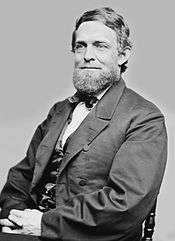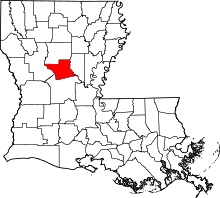Colfax, Louisiana
| Colfax | |
|---|---|
| Town | |
| Town of Colfax | |
|
Colfax City Hall | |
| Coordinates: 31°31′11″N 92°42′30″W / 31.51972°N 92.70833°WCoordinates: 31°31′11″N 92°42′30″W / 31.51972°N 92.70833°W | |
| Country |
|
| State |
|
| Founded | 1869 |
| Parish Seats | Grant Parish |
| Metropolitan Area | Alexandria |
| Government | |
| • Type | Mayor |
| • Body | Ossie Clark (D)[1][2] |
| Population (2000) | |
| • Total | 1,659 |
| Time zone | CST (UTC-6) |
| • Summer (DST) | CDT (UTC-5) |
| Zip Code | 71417 |
| Phone Number | 318 |

Colfax is the largest town and parish seat of Grant Parish, Louisiana, United States.[3] The town, founded in 1869, is named for the vice president of the United States, Schuyler M. Colfax, who served in the first term of U.S. President Ulysses S. Grant, for whom the parish is named. Colfax is part of the Alexandria, Louisiana Metropolitan Statistical Area. The population was 1,659 at the 2000 census.
The first weekend of November Colfax hosts the annual Louisiana Pecan Festival, an outgrowth of the centennial celebration of the town held in 1969. The festival, which draws large crowds to Colfax, includes a parade, fireworks, carnival rides, music, and the unveiling of Miss Louisiana Pecan Festival and her court. Pecans are sold whole, cracked, or shelled in bags of ten, fifteen, or twenty pounds and may also be purchased in pie or brittle form.[4]
History
Colfax was settled by European Americans as a Red River port within Rapides Parish. Prior to the American Civil War, it was known as "Calhoun's Landing," named for the cotton and sugar planter Meredith Calhoun, a native of South Carolina. Calhoun also published the former National Democrat newspaper in Colfax.[5]
During the Reconstruction era, Colfax was the scene of the Colfax massacre on Easter, April 13, 1873. Some three white attackers and about 150 African-Americans were killed in one of the most egregious acts of terrorism during reconstruction.[6] A white militia was led against freedmen by Christopher Columbus Nash, elected sheriff on the a Fusionist/Democratic slate. Freedmen were defending Republican officials at the county courthouse and had gathered there as tensions rose in a post-election dispute. A contemporary report by the U.S. military documented the three white fatalities and 105 black victims by name, with 15-20 unidentified blacks found in the Red River.[7][8] Because of the disproportionate number of deaths between whites and blacks, and documented accounts that at least 50 black prisoners were executed while under control of the white militia, 20th-century historians redefined the "riot" as a "massacre." The event is significant because blacks, who comprised the majority in the county, organized to defend themselves and their political rights.
The riot arose from the disputed gubernatorial election of 1872, finally determined in the favor of the Republican William Pitt Kellogg by the federal government. Both the Fusion-Democrats and the Republicans held inaugurations and certified their own slates of local officers. Kellogg had not recognized Nash's election as sheriff. A native of Sabine Parish, Nash had been a Confederate army officer, held as a prisoner of war at Johnson's Island in Ohio from 1863-1865. Following the events of 1873, in 1874, Nash gathered many of the same men to establish the White League, a white supremacist paramilitary organization that operated on behalf of Democrats and eventually had chapters in many areas of Louisiana.[9] It worked to intimidate and attack black voters, to run Republicans out of office, and suppress black voting.
On April 13, 1921 the white citizens of Colfax unveiled a twelve-foot marble obelisk. It read, "In Loving Remembrance, Erected to the Memory of the Heroes, Stephen Decatur Parish, James West Hadnot, Sidney Harris. Who fell in the Colfax Riot, fighting for White Supremacy, April 13, 1873."
In 1950 the state commerce department erected a historical marker identifying the site of the "Colfax Riot"; it says that the militia's victory "marked the end of carpetbag misrule in the South." Because of similar insurgent paramilitary violence in other areas of the state, especially during campaigns and elections, federal troops remained in Louisiana until 1877, when they were removed on orders of U.S. President Rutherford B. Hayes.
In 2007, the Red River Heritage Association was founded to collect and interpret the history of Reconstruction, especially in the Red River area and Louisiana. The association is raising funds to restore a bank in Colfax near the former courthouse site to use as a museum, archives and interpretive center.
On January 15, 2016, the Wal-Mart Neighborhood Market on Main Street in Colfax was among the 296 stores announced for closure. The business began only in May 2015. It will close on January 28; it is considered by Wal-Mart an "express store", rather than the titled Neighborhood Market. Wal-Mart closed all of its 102 "express" locations, which came into being in 2011.[10]
Geography
Colfax is located at 31°31′11″N 92°42′30″W / 31.51972°N 92.70833°W (31.519783, -92.708446)[11] and has an elevation of 95 feet (29.0 m).[12]
According to the United States Census Bureau, the town has a total area of 1.5 square miles (3.9 km2), all of it land.
Demographics
| Historical population | |||
|---|---|---|---|
| Census | Pop. | %± | |
| 1870 | 40 | — | |
| 1890 | 161 | — | |
| 1900 | 190 | 18.0% | |
| 1910 | 1,049 | 452.1% | |
| 1920 | 1,449 | 38.1% | |
| 1930 | 1,141 | −21.3% | |
| 1940 | 1,354 | 18.7% | |
| 1950 | 1,651 | 21.9% | |
| 1960 | 1,934 | 17.1% | |
| 1970 | 1,892 | −2.2% | |
| 1980 | 1,680 | −11.2% | |
| 1990 | 1,696 | 1.0% | |
| 2000 | 1,659 | −2.2% | |
| 2010 | 1,558 | −6.1% | |
| Est. 2015 | 1,524 | [13] | −2.2% |
As of the census[15] of 2000, there were 1,659 people, 600 households, and 408 families residing in the town. The population density was 1,111.3 people per square mile (429.9/km²). There were 709 housing units at an average density of 474.9 per square mile (183.7/km²). The racial makeup of the town was 67.81% African American, 30.98% White, 0.06% Native American, 0.06% Pacific Islander, 0.06% from other races, and 1.02% from two or more races. Hispanic or Latino of any race were 0.54% of the population.
There were 600 households out of which 33.3% had children under the age of 18 living with them, 30.3% were married couples living together, 32.5% had a female householder with no husband present, and 32.0% were non-families. 30.3% of all households were made up of individuals and 12.8% had someone living alone who was 65 years of age or older. The average household size was 2.55 and the average family size was 3.16.
In the town the population was spread out with 29.1% under the age of 18, 8.4% from 18 to 24, 24.4% from 25 to 44, 19.5% from 45 to 64, and 18.6% who were 65 years of age or older. The median age was 36 years. For every 100 females, there were 77.8 males. For every 100 females age 18 and over, there were 73.1 males.
The median income for a household in the town was $17,500, and the median income for a family was $20,000. Males had a median income of $25,313 versus $14,310 for females. The per capita income for the town was $10,155. About 36.3% of families and 41.0% of the population were below the poverty line, including 59.0% of those under age 18 and 25.3% of those age 65 or over.
Education
Colfax residents are zoned to Grant Parish School Board schools. The former Colfax High School was consolidated into Grant High School in Dry Prong.
Notable people
- Rene J. Bienvenu, president of Northwestern State University in Natchitoches from 1977 to 1982, was born in Colfax.
- Terry Ralph Brown, current District 22 state representative from Colfax; one of only two Independents in the Louisiana House of Representatives
- Preston A. "Pap" Dean, Jr., cartoonist of Shreveport Times
- Leonard R. "Pop" Hataway, Grant Parish sheriff, 1976-2008, based in Colfax; resident of Dry Prong
- Allison Kolb, Louisiana state auditor from 1952 to 1956, was born in Colfax. A Baton Rouge attorney, banker, and philanthropist, Kolb ran unsuccessfully for state treasurer in 1968, as a Democrat-turned-Republican.
- W. T. McCain, state representative for Grant Parish 1940 to 1948 and first state district court judge solely for Grant Parish (1976)
- Ed Tarpley, district attorney for Grant Parish from 1991 to 1997
- Richard S. Thompson, state representative from 1972 to 1984
- Celeste Abraham Clark,[16] Ph.D, former senior vice president of global public policy and external relations of the Kellogg Company
References
- ↑ Mayor Ossie Clark is listed among the state and local officials who have endorsed the reelection in 2014 of Democrat U.S. Senator Mary Landrieu.
- ↑ "Landrieu's GOP Endorsements Pale In Comparison To 2008 Election". thehayride.com. Retrieved September 12, 2014.
- ↑ "Find a County". National Association of Counties. Retrieved 2011-06-07.
- ↑ Jeff Matthews (November 3, 2013). "Fun ... in a nutshell: La. Pecan Festival in Colfax gets great weather, big crowd". Alexandria Daily Town Talk. Retrieved November 3, 2013.
- ↑ "Calhoun, Meredith". Louisiana Historical Association, A Dictionary of Louisiana Biography (lahistory.com). Retrieved December 22, 2010.
- ↑ "Colfax Riot", historical marker, Grant Parish Courthouse, Colfax, Louisiana
- ↑ "Military Report on Colfax Riot, 1875", from the Congressional Record, accessed 6 Apr 2008
- ↑ Lane, Charles, The Day Freedom Died: the Colfax Massacre, the Supreme Court, and the Betrayal of Reconstruction, 2008
- ↑ "Nash, Christopher Columbus". A Dictionary of Louisiana Biography (lahistory.org). Retrieved December 16, 2010.
- ↑ "Colfax Wal-Mart to close less than a year after opening". The Alexandria Town Talk. January 15, 2016. Retrieved January 17, 2016.
- ↑ "US Gazetteer files: 2010, 2000, and 1990". United States Census Bureau. 2011-02-12. Retrieved 2011-04-23.
- ↑ "US Board on Geographic Names". United States Geological Survey. 2007-10-25. Retrieved 2008-01-31.
- ↑ "Annual Estimates of the Resident Population for Incorporated Places: April 1, 2010 to July 1, 2015". Retrieved July 2, 2016.
- ↑ "Census of Population and Housing". Census.gov. Archived from the original on May 11, 2015. Retrieved June 4, 2015.
- ↑ "American FactFinder". United States Census Bureau. Archived from the original on 2013-09-11. Retrieved 2008-01-31.
- ↑ John C. Sherwood (December 24, 2011). "Kellogg's Celeste Clark looking forward". Battle Creek Enquirer.
Further reading
- Keith, LeeAnna (2007). The Colfax Massacre: The Untold Story of Black Power, White Terror, & The Death of Reconstruction. New York: Oxford University Press. ISBN 9780195310269.
- Lane, Charles (2008). The Day Freedom Died, The Colfax Massacre, The Supreme Court, and the Betrayal of Reconstruction. New York: Henry Holt and Company. ISBN 9780805089226.
- Tademy, Lalita (2007). Red River: A Novel. Grand Central Publishing. ISBN 0446578983.
External links
| Wikivoyage has a travel guide for Colfax, Louisiana. |
